Cloud computing is dominating and impacting the world massively. The dominance of hyperscalers in the public cloud infrastructure market is incredibly strong, with AWS alone accounting for nearly 45% of IaaS revenue in 2018. Despite this, the market is substantial, projected to grow at a compound annual growth rate (CAGR) of over 14% until 2023, surpassing $39 billion, according to 451 Research’s Market Monitor service. Despite the market leaders’ stronghold, there is still an attractive opportunity for alternative cloud vendors like DigitalOcean.
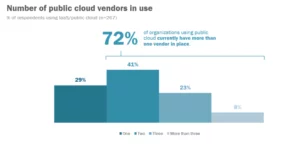
About DigitalOcean
In recent years, DigitalOcean has expanded its range of features, transforming from a provider of affordable and straightforward virtual machines (VMs) into a credible alternative for public cloud services. It was founded in 2011 and has emerged as industry leader and as cloud infrastructure provider, offering scalable and reliable solutions to developers and businesses worldwide. With its user-friendly interface, robust features, and competitive pricing, DigitalOcean has become a popular choice for individuals and organizations seeking a hassle-free cloud computing experience.
DigitalOcean, the Infrastructure-as-a-Service (IaaS) provider, has broadened its focus beyond individual developers by enhancing its features and offerings. This expansion aims to cater to the needs of developer teams in startups and small- to medium-sized businesses. Let’s highlight the advantages and disadvantages of DigitalOcean, discuss its pricing structure, explore its performance capabilities, and take a look at some user reviews and frequently asked questions.
Advantages of DigitalOcean
- Simplicity and Ease of Use: DigitalOcean is renowned for its user-friendly interface and streamlined experience. Setting up a droplet (their term for a virtual machine) is a straightforward process, allowing users to quickly launch and manage their cloud infrastructure.
- Cost-Effective Pricing: DigitalOcean offers transparent and affordable pricing plans. Their straightforward pricing structure, known as “Droplets,” allows users to pay specifically for the resources they need. This makes it a profitable option for individuals and small businesses with budget constraints.
- Scalability and Flexibility: DigitalOcean provides seamless scalability, allowing users to easily increase or decrease resources based on their requirements. This makes it a perfect platform for applications and websites that experience fluctuating traffic.
- Extensive Documentation and Community Support: DigitalOcean offers a comprehensive knowledge base and extensive documentation that guides users through various topics and issues. Additionally, its active community of developers provides support and fosters collaboration.
- Developer-Focused Features: DigitalOcean offers a range of features and tools that specifically cater to developers, including pre-configured one-click application deployments, easy integration with popular development frameworks, and a robust API for automation.
- Robust API and Integration: DigitalOcean offers a comprehensive API that permits users to automate and integrate their infrastructure management with other tools and platforms. This enables seamless workflow automation and integration with popular DevOps tools.
- Predictable Billing: DigitalOcean provides transparent and predictable billing, allowing users to easily estimate and manage their cloud infrastructure costs. This helps in budget planning and prevents unexpected expenses.
- High Availability: DigitalOcean’s infrastructure is fabricated to provide high availability and redundancy. It incorporates features like automated backups, snapshots, and floating IPs, ensuring that your applications and data are protected against failures.
- Developer Community: DigitalOcean has an active and vibrant developer community. It organizes meetups, webinars, and hackathons, fostering knowledge sharing and collaboration among developers. The community also contributes to open-source projects and shares valuable resources.
- Simple Load Balancing: DigitalOcean offers load balancers as a service, allowing users to distribute incoming traffic across multiple droplets for improved performance and availability. The load balancer setup is straightforward and can be managed through the user interface or API.
Disadvantages of DigitalOcean
- Limited Service Offerings: Compared to some other cloud providers, DigitalOcean has a more focused set of services. While it excels in providing virtual machines (droplets), block storage, and managed databases, it may not offer the same breadth of services as larger providers like AWS or Azure.
- Geographic Availability: DigitalOcean has data centers in limited geographic regions compared to some other major cloud providers. This can be a limitation for customers who require data centers in specific locations.
- Reliance on Community Tutorials: While DigitalOcean’s documentation and community tutorials are helpful, they may not always provide answers to specific or unique use cases. In such cases, users might need to rely on external resources or reach out to support.
- Limited Enterprise Features: DigitalOcean primarily caters to developers and small to medium-sized businesses. It may lack some enterprise-grade features required by large organizations, such as advanced security compliance certifications or dedicated account managers.
- Complex Networking Configurations: While DigitalOcean provides networking capabilities, configuring more complex networking setups can be challenging. Advanced networking configurations, such as Virtual Private Clouds (VPCs) or custom network topologies, may require additional knowledge and expertise.
- Limited Support Options: DigitalOcean offers support through its documentation, community forums, and ticket-based system. However, their support may not be as comprehensive or readily available as some other cloud providers that offer phone support or dedicated account managers.
- Limited Database Options: While DigitalOcean offers managed databases for popular options like PostgreSQL, MySQL, and Redis, the range of available database options is relatively limited compared to larger cloud providers. If you require specific or less common database technologies, you may need to consider other alternatives.
- Complexity of Scaling Storage: Although DigitalOcean offers block storage for additional storage needs, scaling storage beyond the limits of a single droplet can be complex. It requires manual configuration and management, which may not be as seamless as some competing cloud providers.
Pricing
DigitalOcean’s pricing model is based on the concept of “Droplets.” Droplets are virtual machines that can be modified with varying amounts of CPU, memory, storage, and bandwidth. The pricing starts at a competitive rate for basic configurations, and additional resources can be added as needed. DigitalOcean also offers a range of additional services like managed databases, block storage, load balancers, and more, each with its own pricing structure.

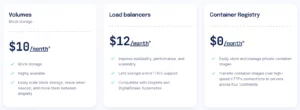

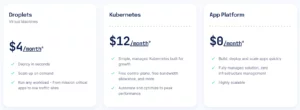
Performance
DigitalOcean boasts impressive performance, with SSD storage and fast networking. The company has strategically placed data centers across different regions, ensuring low-latency connections. Users can select the data center closest to their target audience for optimal performance.
User Reviews
DigitalOcean has received acclaim from both developers and businesses, garnering positive feedback. Its user-friendly interface, pocket-friendly pricing, and impressive performance are highly valued by users. The platform is often commended for its reliability, scalability, and features tailored for developers. However, there have been occasional performance issues and concerns raised about the limited range of services provided.
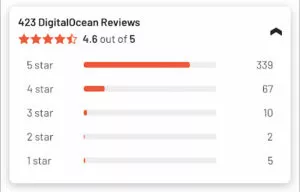



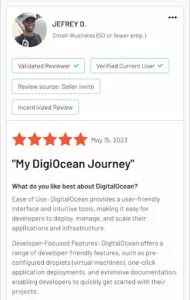
Conclusion
DigitalOcean has earned a reputation for its credibility and being budget-friendly provider of cloud infrastructure, offering a seamless experience, flexibility, and impressive efficiency. It has become a popular preference among individuals, startups, and small to medium-sized enterprises due to its intuitive interface, competitive pricing, and features tailored specifically for developers.
Although DigitalOcean may have certain constraints in terms of the range of services it and its availability in certain regions, its comprehensive documentation, strong community support, and positive feedback from users position it as a formidable player in the realm of cloud computing. If you are a seasoned programmer or a newbie, DigitalOcean offers a reliable platform for deploying and managing your applications in the cloud. Nestify employs DigitalOcean server for all the users and lets them reap maximum benefits of this server.
FAQs
Is DigitalOcean suitable for beginners?
Yes, DigitalOcean is beginner-friendly due to its intuitive interface and extensive documentation. It’s a great platform for learning and developing applications.
Can I easily scale my infrastructure on DigitalOcean?
Yes, DigitalOcean offers seamless scalability. You can easily scale your infrastructure by increasing the resources of your droplets or adding additional droplets to handle increased traffic or workload.
What types of applications can I deploy on DigitalOcean?
DigitalOcean supports a wide range of applications and frameworks. You can deploy web applications, mobile app backends, databases, containers, and more. DigitalOcean also provides one-click application deployments for popular platforms like WordPress, Docker, and Node.js.
How is the security on DigitalOcean?
DigitalOcean prioritizes security and provides several features to safeguard your infrastructure. It includes firewalls, private networking, encrypted storage, and optional two-factor authentication (2FA) for enhanced security. However, it’s crucial to ensure that you configure and manage your infrastructure securely.



